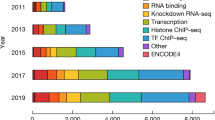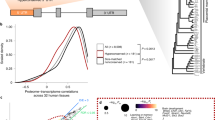Abstract
The nematode worm Caenorhabditis elegans and its relatives are unique among animals in having operons1. Operons are regulated multigene transcription units, in which polycistronic pre-messenger RNA (pre-mRNA coding for multiple peptides) is processed to monocistronic mRNAs. This occurs by 3′ end formation and trans-splicing using the specialized SL2 small nuclear ribonucleoprotein particle2 for downstream mRNAs1. Previously, the correlation between downstream location in an operon and SL2 trans-splicing has been strong, but anecdotal3. Although only 28 operons have been reported, the complete sequence of the C. elegans genome reveals numerous gene clusters4. To determine how many of these clusters represent operons, we probed full-genome microarrays for SL2-containing mRNAs. We found significant enrichment for about 1,200 genes, including most of a group of several hundred genes represented by complementary DNAs that contain SL2 sequence. Analysis of their genomic arrangements indicates that >90% are downstream genes, falling in 790 distinct operons. Our evidence indicates that the genome contains at least 1,000 operons, 2–8 genes long, that contain about 15% of all C. elegans genes. Numerous examples of co-transcription of genes encoding functionally related proteins are evident. Inspection of the operon list should reveal previously unknown functional relationships.
This is a preview of subscription content, access via your institution
Access options
Subscribe to this journal
Receive 51 print issues and online access
$199.00 per year
only $3.90 per issue
Buy this article
- Purchase on Springer Link
- Instant access to full article PDF
Prices may be subject to local taxes which are calculated during checkout



Similar content being viewed by others
References
Spieth, J., Brooke, G., Kuersten, S., Lea, K. & Blumenthal, T. Operons in C. elegans: Polycistronic mRNA precursors are processed by trans-splicing of SL2 to downstream coding regions. Cell 73, 521–532 (1993)
Huang, X.-Y. & Hirsh, D. A second trans-spliced RNA leader sequence in the nematode Caenorhabditis elegans. Proc. Natl Acad. Sci. USA 86, 8640–8644 (1989)
Blumenthal, T. & Steward, K. in C. Elegans II (eds D. L. Riddle et al.) 117–145 (Cold Spring Harbor Laboratory Press, Cold Spring Harbor, 1997)
Zorio, D. A. R., Cheng, N., Blumenthal, T. & Spieth, J. Operons represent a common form of chromosomal organization in C. elegans. Nature 372, 270–272 (1994)
Stein, L., Sternberg, P., Durbin, R., Thierry-Mieg, J. & Spieth, J. WormBase: network access to the genome and biology of Caenorhabditis elegans. Nucleic Acids Res. 29, 82–86 (2001)
Kent, W. J. & Zahler, A. M. The intronerator: exploring introns and alternative splicing in Caenorhabditis elegans. Nucleic Acids Res. 28, 91–93 (2000)
Raboul, J. et al. Open-reading-frame sequence tags (OSTs) support the existence of at least 17,300 genes in C. elegans. Nature Genet. 27, 332–336 (2000)
Williams, C., Xu, L. & Blumenthal, T. SL1 trans-splicing and 3′ end formation in a unique class of Caenorhabditis elegans operon. Mol. Cell. Biol. 19, 376–383 (1999)
Evans, D. et al. Operons and SL2 trans-splicing exist in nematodes outside the genus Caenorhabditis. Proc. Natl. Acad. Sci. USA 94, 9751–9756 (1997)
Huynen, M. A., Snel, B. & Bork, P. Inversions and the dynamics of eukaryotic gene order. Trends Genet. 17, 304–306 (2001)
Page, A. P. Cyclophilin and protein disulphide isomerase genes are co-transcribed in a functionally related manner in Caenorhabditis elegans. DNA Cell Biol. 16, 1335–1343 (1997)
Huang, L. S., Tzou, P. & Sternberg, P. W. The lin-15 locus encodes two negative regulators of Caenorhabditis elegans vulval development. Mol. Biol. Cell 5, 395–412 (1994)
Clark, S. G., Lu, X. & Horvitz, H. R. The Caenorhabditis elegans locus lin-15, a negative regulator of a tyrosine kinase signalling pathway, encodes two different proteins. Genetics 137, 987–997 (1994)
Treinin, M., Gillo, B., Liebman, L. & Chalfie, M. Two functionally dependent acetylcholine subunits are encoded in a single Caenorhabditis elegans operon. Proc. Natl Acad. Sci. USA 95, 15492–15495 (1998)
Mazroui, R., Puoti, A. & Kramer, A. Splicing factor SF1 from Drosophila and Caenorhabditis: presence of an N-terminal RS domain and requirement for viability. RNA 5, 1615–1631 (1999)
Furst, J. et al. ICln ion channel splice variants in Caenorhabditis elegans. Voltage dependence and interaction with an operon partner protein. J. Biol. Chem. 277, 4435–4445 (2002)
Culetto, E. & Sattelle, D. B. A role for Caenorhabditis elegans in understanding the function and interactions of human disease genes. Hum. Mol. Genet. 9, 869–877 (2000)
Reinke, V. et al. A global profile of germline gene expression in C. elegans. Mol. Cell 6, 605–616 (2000)
Jiang, M. et al. Genome-wide analysis of developmental and sex-regulated gene expression profiles in Caenorhabditis elegans. Proc. Natl Acad. Sci. USA 98, 218–223 (2001)
Acknowledgements
We thank J. Spieth, J. Kent, A. Zahler and L. Stein for help with navigation of the C. elegans databases, Y. Kohara for cDNA data, M. Huang for discussions, I. Shah for statistical advice, D. Guiliano and M. Blaxter for communication of unpublished results, and P. MacMorris for advice on the manuscript. This work was supported by the NIH (T.B., C.D.L. and S.K.K.).
Author information
Authors and Affiliations
Corresponding author
Ethics declarations
Competing interests
The authors declare that they have no competing financial interests.
Supplementary information
Table 1 (HTM 102 KB)
Genes with SL2-containing cDNA Clones
Table 2 (HTM 512 KB)
List of operons found from the SL2 DNA microarray experiments and predicted by gene structure. Underline denotes cDNA clones containing SL2, bold or red denote genes supported by microarray data
Table 3 (HTM 2 KB)
Co-expression of related genes in the same operon
Table 4 (HTM 3 KB)
Frequencies of having two genes with the same annotation in the same operon
Table 5. Results from DNA microarrays on SL2 enrichment
-
ORFNAME: unique identifier of the gene
-
SUID: unique Stanford gene identification
-
Expt1
-
Expt2
-
Expt3
-
Expt4
-
Expt5
-
Log(SL2/polyA): average of the log2 of the SL2/polyA ratio
-
STD: standard deviation
-
# exp: number of datapoints used
-
confidence: confidence level from t-test
Table 6 (HTM 77 KB)
List of gene pairs on which the gene spacing was determined
Full data for the DNA microarrays are available at the Stanford Microarray Database (http://genome-www4.stanford.edu/MicroArray/SMD/).
Rights and permissions
About this article
Cite this article
Blumenthal, T., Evans, D., Link, C. et al. A global analysis of Caenorhabditis elegans operons. Nature 417, 851–854 (2002). https://doi.org/10.1038/nature00831
Received:
Accepted:
Published:
Issue Date:
DOI: https://doi.org/10.1038/nature00831
This article is cited by
-
Quantitative analysis of C. elegans transcripts by Nanopore direct-cDNA sequencing reveals terminal hairpins in non trans-spliced mRNAs
Nature Communications (2023)
-
SLIDR and SLOPPR: flexible identification of spliced leader trans-splicing and prediction of eukaryotic operons from RNA-Seq data
BMC Bioinformatics (2021)
-
Spatiotemporal regulation of liquid-like condensates in epigenetic inheritance
Nature (2018)
-
Dictyocaulus viviparus genome, variome and transcriptome elucidate lungworm biology and support future intervention
Scientific Reports (2016)
-
Identification and functional characterization of bidirectional gene pairs and their intergenic regions in maize
BMC Genomics (2014)
Comments
By submitting a comment you agree to abide by our Terms and Community Guidelines. If you find something abusive or that does not comply with our terms or guidelines please flag it as inappropriate.



